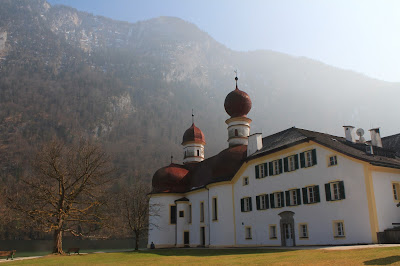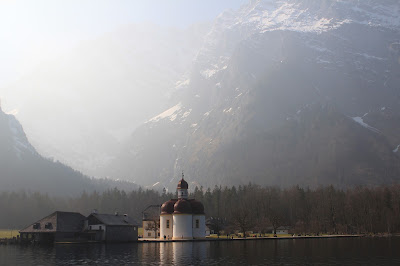I think it’s safe to say that
mountains are my favorite geological feature.
It’s no contest really. The
ocean? Ordinary. The desert?
Drab. The plains? Plain, really. But mountains, oh how they take my breath
away! Rising up out of the Earth and
towering thousands of feet over you; mountains make you feel small and truly
appreciate nature. That is why my final
weekend in Germany was so incredible.
I started off the weekend with a two-hour drive across the
Austrian border to Salzburg. I had been
told by many people of Salzburg’s beauty and history, so I had been wanting to
check it out for a while. I also wanted
to tick a third European country off of my travel list, so Austria was the easy
choice. The drive was beautiful, once
again through the Bavarian countryside towards the Alps. The nicest part about Salzburg, in my
opinion, is the scenery. The city is
nestled right into the edge of the Alps, so it has mountains all around. This was, of course, a strategic decision during
the city’s formation because the mountains provided natural fortification
against ruthless invaders. In fact,
within the city limits are two big hills (I would only call them mountains if I
were from Kansas) that have the remains of the old city wall and an old
fortress. These fortifications allowed
Salzburg to withstand armies many times the size of their own with just a minimal
fighting force. My first goal of the day
was to hike up one of the hills, called Kapuzinerberg, to get the full 360
degree view of the city. This particular
hill was not the one with the fortress on it, because that one has been heavily
touristized and is not as tall. The hike
was nice and fairly easy, and the view at the top was gorgeous. Up and down only took me about an hour and a
half, so that left me with plenty of time to explore the rest of the city.
 |
| Part of downtown Salzburg from part-way up Kapuzinerberg |
 |
| Looking south from Kapuzinerberg over Salzburg |
The downtown area of Salzburg lies in between the two city
hills with the Salzach river cutting it nearly evenly in two. This layout makes the city feel very small
and cozy. Many of the old buildings and
streets are still standing too, so the streets are not even wide enough for two
cars, adding to the small and cozy feeling.
The coolest part is that most of these streets and plazas have been made
into pedestrian zones. I love when
cities do this! It creates areas where
pedestrians can roam and not worry constantly about their safety. This draws people to those areas, helping to
support businesses, restaurants, and museums, and it results in a much quieter,
more relaxing visit. So, I walked around
here for a few hours, had some ice cream and a bratwurst, took some pictures,
and enjoyed the sunshine. Along the way
I stopped into Mozart’s Birthplace Museum, the house in which he was born and
raised. That was pretty cool and worth
the visit. I also went inside the Dom zu
Salzburg (Salzburg Cathedral), which was gorgeous. I love visiting churches in the cities I
visit, especially the Roman Catholic churches.
They’re always so different from one another but also so similar in many
ways since, well, they’re all churches.
After wandering back through the flowery Mirabellgarten, I hopped back
in my car and drove back to Munich for the night.
The next day I drove all the way back to Berchtesgaden,
where I had toured the salt mine, to visit Königssee (King’s Lake). This lake is the only way into the
Berchtesgaden National Park, an 81 square mile park located just south of the
town. Several mountains are prominently located
within the park, the most famous being Watzmann, the third tallest mountain in
Germany at 8901 feet. There are several
lodges located within the mountains, so this is a popular location for
backpackers to plan multiple day trips across the peaks. However, if you do want to do this, you need
to buy a ticket for a boat ride out to a stop halfway down the lake to start
your hike because the shores are really just cliffs with no way around. It truly is a secluded area barely touched by
mankind. The lake itself is so closely
surrounded by the mountains that you can barely see any of it from the northern
end, where you have to park your car. You
don’t realize how beautiful the area really is until you’re on that boat and
turn the first corner to see the length of the lake open up in front of you
with the mountains rising up out of the pristine water on either side. Part of the way down the lake, the boat stops
and the driver plays a trumpet, using the echoes from the cliffs to create a nice
song in the form of a round, before continuing the journey once again. The boat took me, and several hundred other
tourists that day, to our stop at the St. Bartholomä (Bartholomew) church that
is located on a small peninsula about three quarters of the way down the length
of the lake. Kirche St. Bartholomä is a
Roman Catholic pilgrimage church that was built in 1697 on the site of another
chapel that had been there since 1134.
The church has two onion dome towers, a red domed roof, and a view that’s
to die for. Next to the church is an old
hunting lodge that is now a restaurant and biergarten. Thankfully, the weather was warm and sunny,
so I got to sit outside with a couple of beers and a plate of Wiener schnitzel. After my meal, I walked around some of the
hiking paths on the peninsula, but didn’t go very far because I didn’t have
proper hiking shoes. My only regret
about the trip was that the sky was very hazy, so my pictures didn’t turn out
super clear. Thankfully they’re good
enough to portray the beauty of the place, but I’ll have to come back again to
get some better ones!
 |
| Me getting in the way of an otherwise beautiful view of Königssee |
Sunday was one of the most relaxing days of my trip and was
definitely my favorite day so far. I
also believe that Königssee is the most beautiful place that I’ve ever been to
and is the most beautiful place on Earth, though I would love for you to prove
me wrong.






No comments:
Post a Comment